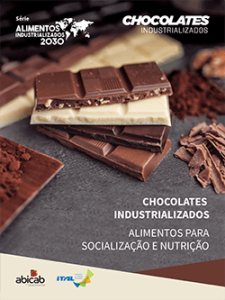NUTRITIONAL VALUE OF INDUSTRIALIZED CHOCOLATES
There are different types of chocolates and products with cocoa, among them, milk, dark, white or ruby chocolate. Each type is composed of different ingredients, which impacts in differences in the nutritional composition and caloric value. Products can be added with peanuts, chestnuts, almonds and fruits, etc., which provide them more or less contents of proteins, fibers and caloric value.
In the nutritional label of the 483 products studied, the nutrients of mandatory statement were identified: Proteins, Fibers (Dietary fiber), Calories (Energy value, kcal), Carbohydrates, Saturated fat, Trans fat and Sodium. Total sugars were tabulated when available on the product labels. It is important to note that there ave many other nutrients, such as bioactive compounds, among other natural components from the ingredients used in the produces, which could not be assessed as their values are not included in the label.
In addition to the sensory stimuli capable of generating well-being, studies have discussed other relevant benefits of chocolate and cocoa to the human health, and highlighting its potential as a food that supplies phenolic compounds.
PROTEINS
The sample analysis of 43 products revealed that many industrialized chocolates contribute with significant quantities of PROTEINS for the consumers feeding and nutrition, despite the wide variation in the quantities present in the different products (Note: the information contained in the labels analyzed do not allow verifying whether proteins have the amino acids profile for the statement of protein nutritional claim). Indeed, as mentioned in the chapter on trends, even though chocolates are traditionally comfort food and pleasant products, innovations have been launched with claims of higher protein content.
DIETARY FIBERS
The sample analysis revealed that many chocolates can be considered as SOURCE of DIETARY FIBERS for the consumers feeding and nutrition, and some of them have a HIGH content of fibers. Likewise, as observed for products with higher content of proteins, the fortification with fibers, vitamins, minerals, fruits, seeds etc., it is a strong trend in order to meed the consumers that want to ally comfort food with nutrition.
CALORIES (ENERGY VALUE)
Generally, chocolates ate not products of low caloric content, as they are compound by cocoa butter, milk, sugar, among other ingredients characteristics for this product, such as peanut, almonds, nuts, chestnuts.
However, the quantities of calories vary significantly among the analyzed products. As observed in the chapter on market trends, products have been developed with reduced energy value, with ingredients reformulation and fats reduction.
CARBOHYDRATES
Generally, industrialized chocolates usually don’t chocolates usually contain high quantities of CARBOHYDRATES, but it depends on the type of ingredients which are mixed, such as, for example, cookies, wafers, among others.
TOTAL SUGAR
Generally, chocolates usually contain TOTAL SUGAR in its preparation. However, there are several products with reduction in the sugar content, and even “zero-sugar” chocolates, result of the increasingly trend to control the sugar in the food diet, as highlighted in the chapters on trends. As the total sugar statement now must be mandatory, and the labels are still in the adaptation phase, only products with this information in their labels or websites were considered.
SATURATED FAT
In average, chocolate has SATURATED FAT in its composition, mainly from cocoa; however, the quantities can vary according to the ingredients used.
TRANS FAT
The quantities of TRANS FAT in hamburgers vary significantly according to the ingredients present in their formulation. Most products analyzed have a non-significant quantities of trans fat.
According to the analyzed sample, most industrialized chocolates do not have TRANS FAT. For example, among the 483 products of the total sample, only 4 presented quantities higher than 0.1 g, due to the fillings composition, and not by the chocolate natural characteristics.
SODIUM
The quantity of SODIUM in chocolates varies a lot among the different types of products, there are several products with no or low sodium content. For example, among the dark/semi sweet chocolate bars, 40.4% have 0,0 mg e 51,7% have up to 40 mg in each 50 g.




